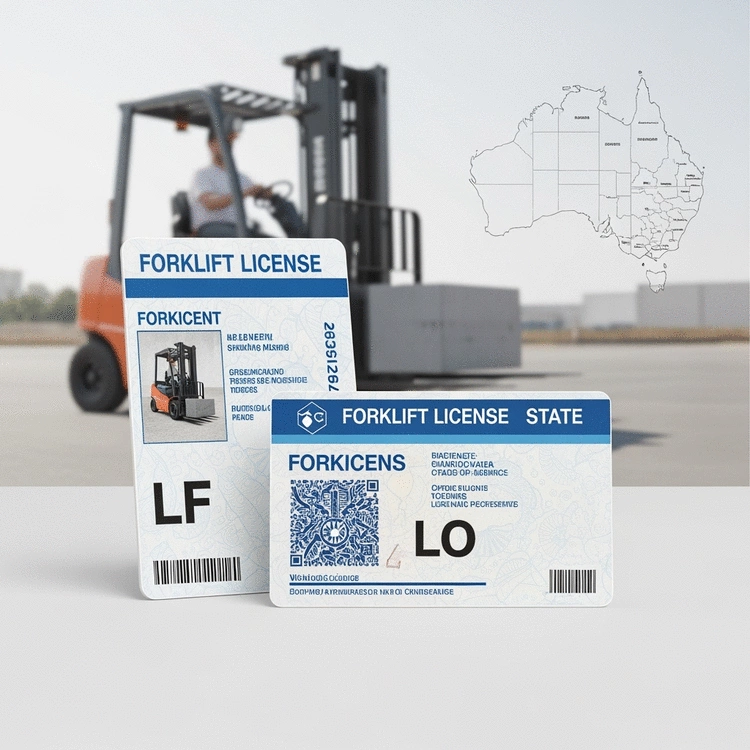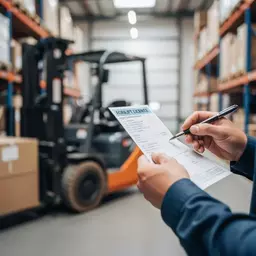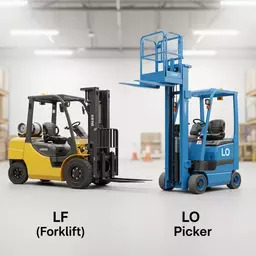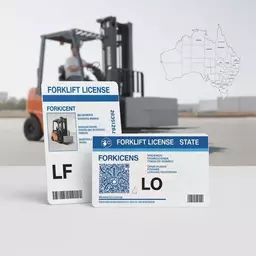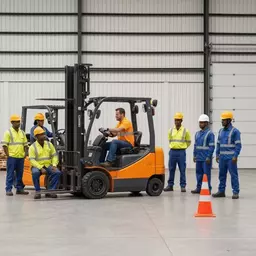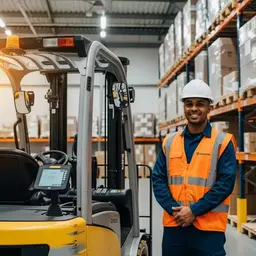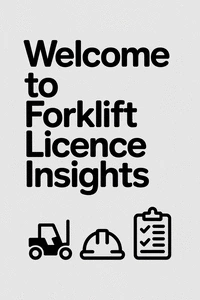Consider this: obtaining a forklift license can open the door to numerous career opportunities in various industries, yet many still find the process daunting. Understanding the nuances of the LF and LO licenses is essential for safety and compliance in the workplace. Ready to embark on your forklift journey?
What You Will Learn
- The LF forklift license is essential for operating high-risk forklifts like counterbalance and reach forklifts, ensuring safe handling in logistics and construction.
- To obtain an LF license, candidates must be at least 18 years old, complete mandatory training, and pass both practical and theoretical assessments.
- The LO license is specifically for order-picking forklifts, focusing on safe operation in high-reach environments, critical for warehouse and distribution sectors.
- Safe Work Australia sets nationwide safety regulations that forklift operators must adhere to, enhancing workplace safety and compliance.
LF vs. LO Forklift License Requirements
A side-by-side comparison of the key requirements and distinctions between LF (high-risk forklifts) and LO (order picking forklifts) licenses in Australia. For a deeper dive into the specifics, check out our guide on forklift license training in NSW.
Understanding LF and LO Forklift Licenses in Australia
Getting your forklift license is a significant step toward a fulfilling career in various industries! In this section, we’ll delve into the specifics of the two main types of forklift licenses in Australia: the LF (for high-risk forklifts) and the LO (for order picking forklifts). Understanding these licenses is crucial for compliance and safety in the workplace.
Overview of LF Forklift License Requirements
Definition and Purpose of LF Licenses
The LF forklift license is designed for operators who handle high-risk forklifts. This includes various types of forklifts like counterbalance, side-loader, and reach forklifts. The primary purpose of the LF license is to ensure that operators are trained to operate these machines safely and efficiently, minimizing risks in the workplace.
Having an LF license means you’re not just certified but also empowered to handle powerful machinery responsibly. It’s a vital credential in the logistics, construction, and warehousing industries, where safe operation is non-negotiable!
General Requirements for LF Licenses
- Minimum Age: You must be at least 18 years old to apply.
- Training: Completion of a training course through a registered training organization (RTO) is mandatory.
- Assessment: A practical and theoretical assessment must be passed to receive your license.
- Medical Fitness: You need to ensure you are medically fit to operate a forklift.
These requirements are in place to ensure the safety of both the operator and those around them. If you meet these prerequisites, you’re on your way to obtaining your LF license! To learn more about specific training options, explore our guide on how to get a forklift license.
Overview of LO Forklift License Requirements
Definition and Purpose of LO Licenses
The LO forklift license is specifically aimed at operators who use order picking forklifts, which are essential in warehouses for retrieving products from high shelves. This type of license focuses on ensuring that operators can safely navigate these high-reach environments.
Having an LO license not only expands your qualifications but also increases your job opportunities in sectors like retail and distribution. Safety is paramount, and being certified ensures you’re prepared for the challenges of operating these specialized forklifts.
General Requirements for LO Licenses
- Minimum Age: Applicants must be at least 18 years old.
- Training: Completion of an RTO training program specific to order picking equipment is required.
- Assessment: A practical and theoretical assessment must be successfully completed.
- Medical Fitness: Operators must be medically fit to operate this equipment.
These streamlined requirements ensure that only qualified individuals operate order picking forklifts, enhancing overall safety standards in the workplace.
The Role of Safe Work Australia in Forklift Licensing
Key Safety Regulations Set by Safe Work Australia
Safe Work Australia plays a pivotal role in establishing nationwide safety regulations for forklift operations. These regulations are designed to protect both operators and the public by ensuring that all forklift operations meet high safety standards.
Understanding these regulations can significantly help you in your journey towards obtaining your forklift license. It’s your assurance that the training and practices you engage in are aligned with best practices across the industry.
National Standard for Licensing Persons Performing High Risk Work
This standard is a critical component for anyone entering the forklift operating industry. It outlines the necessary competencies required to fulfill the responsibilities associated with high-risk work, including the operation of forklifts.
By adhering to these guidelines, operators not only comply with legal requirements but also contribute to a safer work environment. Always stay informed about any updates from Safe Work Australia to maintain compliance and safety in your career as a forklift operator! For more information on the national standards, see our post on forklift license costs and what they cover.
Engage with Us!
We want to hear your thoughts! What challenges have you faced while pursuing your forklift license? Share your experiences or tips with us below:
Engaging with Forklift License Requirements Effectively
Understanding the requirements for LF and LO forklift licenses can feel overwhelming. However, addressing common questions and providing resources can simplify this process. Let’s dive into some of the most frequently asked questions regarding these licenses.
Common Questions About LF and LO Licenses
One of the first things people ask is, “What training is required for LF and LO licenses?” The training varies based on the type of license, which directly influences the forklift operation you’ll be performing. For LF licenses, training typically includes:
- Theory lessons covering safety regulations and operational principles
- Practical training on actual forklifts to enhance hands-on skills
- Assessment to ensure competency before licensing
For LO licenses, the training is similar but focuses specifically on order-picking forklifts. Understanding these distinctions is crucial for making informed decisions about which license suits your needs!
What Training is Required for LF and LO Licenses?
In general, the training for both types of licenses involves a mix of theory and practical components. Both licenses require participants to undergo training through a registered training organization (RTO). It's essential to choose an RTO accredited to deliver the training relevant to the license you need. This not only ensures quality training but also compliance with the National Standard for Licensing Persons Performing High Risk Work.
How to Choose Between LF and LO Licenses for Your Needs
When deciding which license to pursue, consider your work environment and the specific tasks you’ll be performing. If you're primarily operating standard forklifts in warehouses or construction sites, the LF license is for you. Conversely, if your job involves using order-picking forklifts, then an LO license is essential. Weighing these factors can help you make a choice that aligns with your career goals!
Visual Aids and Resources for Understanding Forklift Regulations
To make the learning process easier, visual aids can be incredibly helpful. Infographics can distill complex information into digestible formats. For example, a visual guide outlining the differences between LF and LO licenses can quickly clarify requirements. Here’s a quick overview of common visual aids:
- Infographics comparing LF and LO license requirements
- Flowcharts depicting the licensing process
- Charts detailing safety standards and compliance steps
These tools not only enhance understanding but can also serve as handy references throughout your training journey.
Infographics: Quick Reference for LF and LO License Requirements
Using infographics can serve as a valuable resource for quickly grasping the essentials of forklift licensing. They often highlight key points like:
- Training requirements for LF and LO licenses
- Differences in operational scope
- Safety standards and compliance measures
Look for infographics on reputable industry websites or through your training provider. They make complex information far more accessible!
Links to Official Regulatory Bodies and Training Resources
Another excellent way to engage with forklift license requirements is by utilizing official resources. Below are some useful links:
- Safe Work Australia - For comprehensive safety regulations
- Training.gov.au - For RTO listings and training requirements
- WorkSafe NSW - For state-specific compliance information
These resources are invaluable for anyone looking to deepen their understanding of forklift licensing and compliance.
Understanding the Licensing Process: Fees and Renewal
The next question many prospective forklift operators ask is about the fees and the application process. Knowing what to expect can ease any apprehension surrounding the licensing journey. Here’s a brief overview of what you’ll encounter:
- Application fees vary by state and type of license
- Costs associated with training courses provided by RTOs
- Additional fees for assessment and issuing of the license
Understanding these costs upfront will help you budget for your journey into forklift operation more effectively!
Overview of Licensing Fees and Application Process
The application process generally involves submitting your identification and proof of training completion to your local licensing authority. Each state has its own specific requirements that may include a fee structure. It’s best to consult your local authority’s website for the most accurate information. Knowing the steps beforehand can significantly streamline your application!
Steps Involved in the Renewal Process for Forklift Licenses
Once you obtain your license, don’t forget about the renewal process! Here are the steps typically involved:
- Complete any required training or refresher courses
- Gather necessary documentation, such as your ID and current license
- Submit your renewal application to the relevant authority
It’s crucial to keep track of your license expiry date, ensuring that you remain compliant and avoid any disruptions in your forklift operation capabilities.
Frequently Asked Questions About Forklift Licenses
- What is the difference between an LF and an LO forklift license?
- An LF (Load Shifting) license is for operating high-risk forklifts like counterbalance and reach forklifts, used in general logistics and construction. An LO (Order Picking) license is specifically for order-picking forklifts, designed for retrieving goods from high shelves in warehouses and distribution centers.
- What are the age requirements for obtaining a forklift license in Australia?
- For both LF and LO forklift licenses in Australia, applicants must be at least 18 years old.
- Is training mandatory to get a forklift license?
- Yes, completion of a training course through a registered training organization (RTO) is mandatory for both LF and LO licenses. This includes both theoretical and practical assessments.
- Who sets the safety regulations for forklift operations in Australia?
- Safe Work Australia plays a pivotal role in establishing nationwide safety regulations for forklift operations, ensuring high safety standards and compliance across various industries.
- How do I choose between an LF and an LO license?
- Your choice should be based on your work environment and the specific tasks you'll perform. If you operate standard forklifts in warehouses or construction, the LF license is suitable. If your job involves order-picking forklifts for high-shelf retrieval, an LO license is essential.
- What is the National Standard for Licensing Persons Performing High-Risk Work?
- This standard outlines the necessary competencies required for individuals performing high-risk work, including forklift operation. Adhering to it ensures legal compliance and contributes to a safer work environment.
Recap of Key Points
Here is a quick recap of the important points discussed in the article:
- LF Forklift License: Required for operating high-risk forklifts; minimum age is 18, and completion of a training course is mandatory.
- LO Forklift License: Specifically for order picking forklifts; also requires a minimum age of 18 and a completed RTO training program.
- Safe Work Australia: Establishes key safety regulations that ensure compliance and safety for forklift operations.
- Training Requirements: Both LF and LO licenses involve a combination of theoretical lessons and practical training.
- Application Process: Fees vary by state; understanding the costs involved helps in budgeting for the licensing journey.
- Renewal Process: Keep track of expiry dates, and ensure to complete any required refresher training to maintain compliance.
